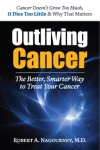The Future of Cancer Research
April 25, 2013 1 Comment
The American Association for Cancer Research meeting held April 6 – 10 in Washington DC, provided a scientific perspective on oncologic developments. As opposed to the more clinical American Society of Clinical Oncology (ASCO), basic scientists attend this meeting, a large percentage of who are PhDs. The conference affords these investigators the opportunity to discuss their basic research and to present methodology workshops. The meeting also provides an early overview of the general direction that cancer research will be taking over the coming years.
While ASCO reports what we’ve recently done, AACR reports what we will be doing.
 There were several overarching themes at this year’s meeting, the most prominent of these being the remarkable strides in immunologic therapy. Numerous investigators reported novel developments in the field. Where the immune system used to present as an insurmountable barrier of complexity, today we have dissected specific response elements and immune suppressive pathways that offer unique opportunities for therapy. Immunologic therapeutics are now specializing into sub-domains.
There were several overarching themes at this year’s meeting, the most prominent of these being the remarkable strides in immunologic therapy. Numerous investigators reported novel developments in the field. Where the immune system used to present as an insurmountable barrier of complexity, today we have dissected specific response elements and immune suppressive pathways that offer unique opportunities for therapy. Immunologic therapeutics are now specializing into sub-domains.
One productive area reflects de-repression. The most mature example being ipilimumab, the monoclonal directed against CTLA-4. This broadly expressed T-cell repressor molecule can be de-repressed resulting in significant anti-tumor activity, but with moderate to severe toxicity. The inhibition of PDL-1 is more selective and therefore less toxic, it has provided responses in melanoma, NSCLC and other diseases.
Earlier stage research is also focusing on tryptophan metabolism and the role of indoleamine 2, 3-dioxygenase. Manipulations of dendritic cells, altering prostaglandin TGF beta, IL-10, IL-6 and the STAT3 signaling pathway are also areas of active investigation. Additional studies included transferred receptors, like the CD19-related chimeric antigen receptor work and the targeting of co-stimulatory molecules like CD28.
Among the most striking observations in this field is the role of the human immune system and the tumor microenvironment in tumor promotion. Immunologists are rapidly learning that cancer is much more than just cancer cells.
The second broad concept that occurred repeatedly was the growing recognition of cancer as an organismal disease. When we realize that circulating tumor cells can be identified in the blood stream and bone marrow of virtually all cancer patients, even in many of those with putative in-situ disease, it becomes evident that invasive malignancies occur as the intersection of a primed cell and a receptive microenvironment. In light of our laboratory’s long held belief in the concept of native state microspheroids as predictive models (as used in our EVA-PCD® platform), this theme was highly appealing.
The developing principle that most closely approximated our work was captured in a special symposium organized by Charles Sawyer, president-elect of AACR. The topic of this well-attended session was the “N of 1.” That is, every patient is his or her own clinical trial. Nothing could be closer to our own work. During this session, two new directions for cancer research were described. The first, described as the “P2G,” was characterized by “exceptional responses.” The developing program through the NCI will collect tissue samples from patients who have had especially good responses from therapy and attempt to drill down on the mechanism of response. This exemplifies the phenotype to genotype (P2G). The second concept was the “G2P.” This reflects genomic screening, leading to the identification of lead targets followed by the administration of treatments. This “genotype to phenotype” approach is the one more closely aligned with investigations being conducted today at major centers here and abroad.
It is the exceptional response (phenotype to genotype) approach that most resonated. After all we have pioneered the field of phenotypic analysis. To wit, the use of human tissues in primary culture can offer the opportunity to explore literally dozens of exceptional responses in every patient’s tissues. A hit could provide insights for mechanistic discovery. It is my hope that this P2G paradigm will take hold – I see it as the most productive direction.



